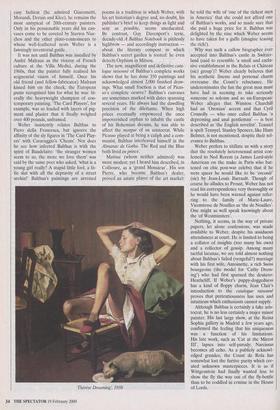BOOKS
The quest for Rola
Frederic Raphael
BALTHUS: A BIOGRAPHY by Norman Fox Weber Weedenfeld, BO, pp. 644 BALTHUS: CATALOGUE RAISONNE OF THE COMPLETE WORKS by Jean Clair and Virginie Monnier Abrams/Gallimard, £140, pp. 576 We have all inadvertently put our thumbs over the lens, but Lee Friedlander, the great American photographer, was probably the first to arrange for his own shadow to fall into the frame. By doing so, he ruptured the illusion that the image was autonomous. Too many modern biogra- phers imitate Friedlander witlessly, by Intruding their own image on their subject's portrait. Norman Fox Weber's account of the great reclusive, anti-modern painter whom we know as Balthus (and whom its subject would have us call Count Balthasar Klossowski de Rola) is as much of Weber's Own person, opinions and hang-ups as of a remarkable life. Descartes remarked that the ivy cannot grow higher than the tree, but he had not observed Weber climbing all over Balthus.
We are informed very soon that the author, the Director of the Josef and Anni Albers Foundation, is descended from `Jews of Breslau'. So, he promises Balthus, is Balthus (whose maternal grandfather was a cantor in the synagogue). Naively, he assumed that his cry of `Lanzmane would recommend him to the painter.
`No, that is wrong, Mr Weber,' he said blithe- ly. Behind his 'it really doesn't matter' tone of voice, there was an underlying vehemence-
How wicked was it of Balthus to fabri- cate an aristocratic persona for himself? All kinds of (con-) artists and, above all, dandies have done as much, or more. What Is it about Jewish origins that Weber has to be so officious in not allowing the fugitive to escape them? Balthus invested much Ingenuity in making himself the Count de Rola, just as Brummell (or Disraeli) did in assuming a presumptuous superiority. If it amuses him, why should it not amuse, rather than embarrass, us?
Isn't modern art all about making one's name? Balthus made himself a fancy one. Even so smart a critic as Robert Hughes was gulled into reporting him as related to the Romanovs, to be the grand-nephew of Lord Byron (like B., he even lived for a season in the Villa Diodati on Lake Leman), descended from the Polish royal family and — of course — the illegitimate son of Rainer Maria Rilke, who was indeed the fatal lover of `Baladine', Balthus's beautiful and romantic mother (all good cover-stories check out to some degree).
Rilke was crucial in validating the young artist's sense of election. The poet's baleful part in shattering his mistress's life, Weber convinces us, impelled the boy to fabricate a compensatory myth in which he was a happy, precocious and un-Oedipal observer of his mother's rapturous heartbreak. When Balthus was 11 years old, he lost his cat, Mitsou. A series of precocious draw- ings advertised his bereavement, and his talent, to the sympathetic Rilke, who added a prefatory imprimatur to the work.
What was lost in life was regained in art; the whole cycle of Balthus's work has con- tinued to be set in an idyllically vicious, pre-modern Arcadia, in which dexterous paint clashes and chimes with sinister imagery. The typical Balthusian figure, with its anatomic distortions (endlessly mea- sured for us by the literal-minded Weber), breathes and exhales nostalgic menace. As carefully posed as the figures in Poussin or Piero della Francesca (a fundamental icon), Balthus's wise-en-scene supplies clas- sic compositional stability to a private world where balance is precarious and every face instinct with duplicity. The 20th century is both ignored and stigmatised, just as its unreliable — dead? — God is religiously honoured by the style and impu- dently quizzed by the content (cf. Courbet's notorious 'Creation%) Cats became part of Balthus's signature; their elusiveness was emblematic of his own feline methods. When he walked by himself, however, he usually had young females with him, models and stisse Mad- chen. Setsuko, his Japanese wife, is 35 years younger than he. Both in his work and in his personal conduct, Balthus rejected accountability to anyone but himself. Like every publishing scoundrel, Weber is mad- dened by his subject's claim that he has no `personality' and hence no dirt to dish. If Balthus has been calculatingly shy of allow- ing the public to see his notorious early work, 'The Guitar Lesson', in which a dom- Matrix is portrayed twanging the naked labia of a prepubescent pupil, for Weber it can only be in order to foster its notoriety or because he flinches from what it reveals about him. True? False? Who cares? The work is the work is the work, and may be a rose, or not, or both. Ars brevis, biographia longer.
Picasso once said that he and Balthus were 'two sides of the same coin'. How much of a compliment was it and what was the coin worth? The two careers were markedly different. Picasso very soon acquired the Midas touch. Restaurateurs preferred him to scribble on the tablecloth rather than to pay the bill. If he declared modern art to he 'the sum of destructions', and was reputed to paint as many as three canvases in a day, he assumed his right to all the traditional prerogatives of genius: women, wealth and adulation. The richer he grew, the showier and more facile he became. Balthus preferred to be ostenta- tiously reclusive. Although he now lives in a Swiss château and parades white-gloved servants, he was, for large parts of his life, an impoverished bohemian. Disdaining easy fashion (he admired Giacometti, Morandi, Derain and Klee), he remains the most untypical of 20th-century painters. Only in his pensionable years did his can- vases come to be coveted by Stavros Niar- chos and the other Pluto-connoisseurs to whose well-feathered nests Weber is a fawningly inventorial guide.
It was not until Balthus was installed by Andre Malraux as the viceroy of French culture at the Villa Medici, during the 1960s, that the painter fully realised his seigneurial vision of himself. Once his old friend (and fellow-fabricator) Malraux kissed him on the cheek, the European gratin recognised him for what he was: lit- erally the heavyweight champion of con- temporary painting. 'The Card Players', for example, was so loaded with layers of pig- ment and plaster that it finally weighed over 400 pounds, unframed.
Weber insistently relates Balthus to Piero della Francesca, but ignores the affinity of the sly figures in 'The Card Play- ers' with Caravaggio's 'Cheats'. Nor does he see how infected Balthus is with the spirit of Baudelaire: 'the stranger women seem to us, the more we love them' was said by the same poet who asked, 'what is a young girl really? A stupid little fool, a lit- tle slut with all the depravity of a street urchin!' Balthus's paintings are arrested poems in a tradition in which Weber, with his art historian's degree and, no doubt, his publisher's brief to keep things as light and sexy as possible, seems uneducated. By contrast, Guy Davenport's terse, decade-old A Balthus Notebook is pitilessly highbrow — and accordingly instruction about the literary compost in which Balthus's secret garden is rooted: he even detects Orphism in Mitsou.
The new, magnificent and definitive cata- logue raisonne of Balthus's complete works shows that he has done 350 paintings and acknowledged almost 2,000 finished draw- ings. What small fraction is that of Picas- so's complete oeuvre? Balthus's canvases are sometimes marked with dates spanning several years. He always had the dawdling precision of the dilettante. When high prices eventually empowered the once impoverished orphan to inhabit the castle of his Bohemian dreams, he was able to affect the morgue of an aristocrat. While Picasso played at being a caliph and a com- munist, Balthus interleaved himself in the Almanac de Gotha. The Red and the Blue both lived en prince.
Matisse (whom neither admired) was more modest: yet I heard him described, in Collioure, as a 'grand Monsieur'. His son Pierre, who became Balthus's dealer, proved an astute player of the art market: `Therese Dreaming, 1938 he told the wife of 'one of the richest men in America' that she could not afford one of Balthus's works, and so made sure that she paid a huge price for it. Balthus was delighted by the ruse which Weber seems to have taken for a gaffe (imagine teasing the rich!).
Why was such a callow biographer ever accepted into Balthus's castle in Switzer- land (said to resemble 'a small and exclu- sive establishment in the Relais et Château (sic) group')? Weber clearly believes that his aesthetic finesse and personal charm overcame the Count's reluctance. He underestimates the fun the great man must have had in seeming to take seriously someone so solemn and so un-European: Weber alleges that Winston Churchill had an 'Oxonian' accent and that Cyril Connolly — who once called Balthus 'a depressing and anal gentleman' — is best described as 'the English novelist'. Tumidl is spelt Tennyel. Stanley Spencer, like Hans Selmer, is not mentioned, despite their rel- evance to Balthus.
Weber prefers to titillate us with a story that the resolutely heterosexual artist con- fessed to Ned Rorem (a James Lord-style American on the make in Paris who bat- tened on chic post-war celebs) that if he were queer he would like to be `encouM' (sic) by Jean-Louis Barrault. Though of course he alludes to Proust, Weber has not read his correspondence very thoroughly or he would have been warned against refer- ring to the family of Marie-Laure, Vicomtesse de Noailles as 'the de Noailles'. One might as well speak knowingly about the 'of Westminsters'.
Nothing, it seems, in the way of private papers, let alone confessions, was made available to Weber, despite his assiduous attendances at court. He is limited to being a collator of insights (too many his own) and a collector of gossip. Among many tactful lacunae, we are told almost nothing about Balthus's failed (vengeful?) marriage with his first wife, Antoinette, a rich Swiss bourgeoise (the model for 'Cathy Dress- ing') who had first spurned the deutero- Heathcliff. If Weber's puppy-doggedness has a kind of floppy charm, Jean Clair's introduction to the catalogue raisonne proves that pretentiousness has uses and intuitions which enthusiasm cannot supply.
Although Balthus is certainly a fake aris- tocrat, he is no less certainly a major minor painter. His last large show, at the Reina Sophia gallery in Madrid a few years ago, confirmed the feeling that his uniqueness was a function of his limitations. His late work, such as 'Cat at the Mirror III', lapses into self-parody; Narcissus becomes all echo. As a publicly acknowl- edged grandee, the Count de Rola has somewhat lost the furtive purity which cre- ated unknown masterpieces. It is as if Wittgenstein had finally wanted less to show the fly the way out of the fly-bottle than to be coddled in ermine in the House of Lords.



































































 Previous page
Previous page